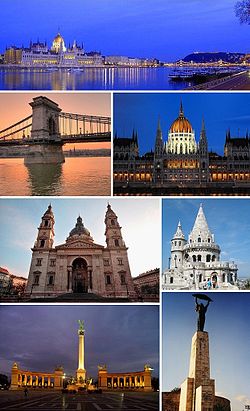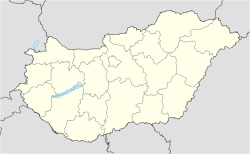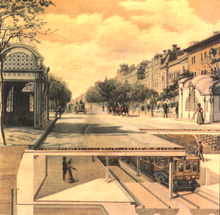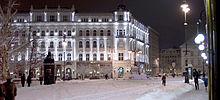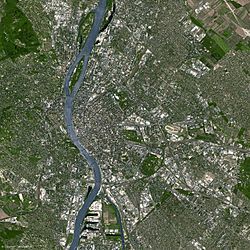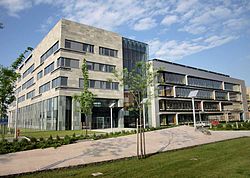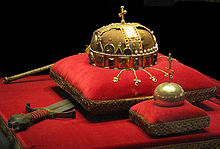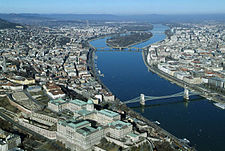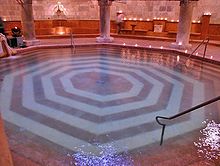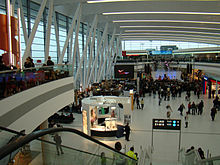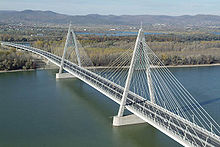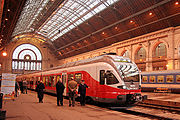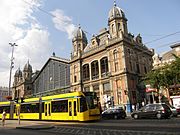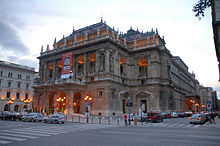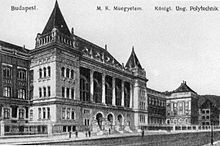
Budapest
About this schools Wikipedia selection
SOS Children volunteers helped choose articles and made other curriculum material See http://www.soschildren.org/sponsor-a-child to find out about child sponsorship.
| Budapest | |||
|---|---|---|---|
| — City — | |||
| From top, left to right: the Parliament Building with the Danube River, the Chain Bridge, the Parliament Building, the St. Stephen's Basilica, the Fisherman's Bastion, the Heroes' Square, the Liberty Statue. | |||
|
|||
| Nickname(s): Heart of Europe, Pearl of Danube, Capital of Freedom, Capital of Spas and Thermal Baths, Capital of Festivals | |||
|
|
|||
| Coordinates: 47°28′19″N 19°03′01″E Coordinates: 47°28′19″N 19°03′01″E | |||
| Country | Hungary | ||
| Region | Central Hungary | ||
| Subregion | Budapesti | ||
| Unification of Buda, Pest and Óbuda | 17 November 1873 | ||
| Boroughs |
23 kerület
|
||
| Government | |||
| • Mayor | István Tarlós ( Fidesz- KDNP) | ||
| Area | |||
| • City | 525.16 km2 (202.77 sq mi) | ||
| • Urban | 2,538 km2 (980 sq mi) | ||
| • Metro | 7,626 km2 (2,944 sq mi) | ||
| Highest elevation | 527 m (1,729 ft) | ||
| Lowest elevation | 96 m (315 ft) | ||
| Population (2011) | |||
| • City | 1,741,041 | ||
| • Rank | 1st | ||
| • Density | 3,300/km2 (8,600/sq mi) | ||
| • Urban | 2,551,247 | ||
| • Urban density | 1,000/km2 (2,600/sq mi) | ||
| • Metro | 3,284,110 | ||
| • Metro density | 430/km2 (1,100/sq mi) | ||
| Demonym | budapesti | ||
| Time zone | CET ( UTC+1) | ||
| • Summer ( DST) | CEST ( UTC+2) | ||
| Postal code(s) | 1011–1239 | ||
| Area code | 1 | ||
| ISO 3166 code | HU-BU | ||
| Website | budapest.hu | ||
Budapest (pron.: / ˈ b uː d ə p ɛ s t /, / ˈ b uː d ə p ɛ ʃ t / or / ˈ b ʊ d ə p ɛ s t /; Hungarian pronunciation: [ˈbudɒpɛʃt]; names in other languages) is the capital and the largest city of Hungary, the largest in East-Central Europe and the seventh largest in the European Union. It is the country's principal political, cultural, commercial, industrial, and transportation centre, sometimes described as the primate city of Hungary. In 2011, according to the census, Budapest had 1.74 million inhabitants, down from its 1989 peak of 2.1 million due to suburbanization. The Budapest Commuter Area is home to 3.3 million people. The city covers an area of 525 square kilometres (202.7 sq mi) within the city limits. Budapest became a single city occupying both banks of the river Danube with a unification on 17 November 1873 of west-bank Buda and Óbuda with east-bank Pest.
The history of Budapest began with Aquincum, originally a Celtic settlement that became the Roman capital of Lower Pannonia. Hungarians arrived in the territory in the 9th century. Their first settlement was pillaged by the Mongols in 1241–42. The re-established town became one of the centres of Renaissance humanist culture in the 15th century. Following the Battle of Mohács and nearly 150 years of Ottoman rule, the region entered a new age of prosperity in the 18th and 19th centuries, and Budapest became a global city after the 1873 unification. It also became the second capital of the Austro-Hungarian Empire, a great power that dissolved in 1918, following World War I. Budapest was the focal point of the Hungarian Revolution of 1848, the Hungarian Republic of Councils of 1919, Operation Panzerfaust in 1944, the Battle of Budapest in 1945, and the Revolution of 1956.
Cited as one of the most beautiful cities in Europe, its extensive World Heritage Site includes the banks of the Danube, the Buda Castle Quarter, Andrássy Avenue, Heroes' Square and the Millennium Underground Railway, the second oldest in the world. Other highlights include a total of 80 geothermal springs, the world's largest thermal water cave system, second largest synagogue, and third largest Parliament building. The city attracts about 4.3 million tourists a year, making it the 25th most popular city in the world (and the 6th in Europe) according to Euromonitor.
Considered a financial hub in Central Europe, the city ranked 3rd (out of 65 cities) on Mastercard's Emerging Markets Index, and ranked as the most livable Central/Eastern European city on EIU's quality of life index. It is also ranked as "Europe's 7th most idyllic place to live" by Forbes, and as the 9th most beautiful city in the world by UCityGuides. It is the highest ranked Central/Eastern European city on Innovation Cities' Top 100 index.
Budapest is home to the headquarters of the European Institute of Innovation and Technology (EIT), and the first foreign office of the China Investment Promotion Agency (CIPA).
Etymology
The name "Budapest" is the composition of the city names " Buda" and " Pest", since they were united (together with Óbuda) to become a single city in 1873. One of the first occurrences of the combined name "Buda-Pest" was in 1831 in the book "Világ" ("World" / "Light"), written by Count István Széchenyi.
The origins of the words "Buda" and "Pest" are obscure. According to chronicles from the Middle Ages the name "Buda" comes from the name of its founder, Bleda (Buda), the brother of the Hunnic ruler Attila. The theory that "Buda" was named after a person is also supported by modern scholars. An alternative explanation suggests that "Buda" derives from the Slavic word "вода, voda" ("water"), a translation of the Latin name " Aquincum", which was the main Roman settlement in the region.
There are also several theories about the origin of the name "Pest". One of the theories claims that the word "Pest" comes from the Roman times, since there was a fortress " Contra-Aquincum" in this region which was referred to as "Pession" ("Πέσσιον", iii.7.§2) by Ptolemaios. According to another theory, "Pest" originates from the Slavic word for cave "пещера, peshtera" or from the word for oven "печь, pesht", in reference to a cave where fires burned or to a local limekiln. In the old-Hungarian language there was a similar word meaning oven/cave and the original old-German name of this region was also "Ofen". Later, the German "Ofen" referred to the Buda side.
History
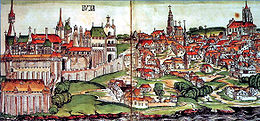
The first settlement on the territory of Budapest was built by Celts before 1 AD. It was later occupied by the Romans. The Roman settlement - Aquincum - became the main city of Lower Pannonia in 106 AD. At first it was a military settlement and gradually the city raised around it becoming the focal point of the commercial life.Today this area correspond to the Óbuda district within Budapest. The Romans constructed roads, amphitheaters, baths and houses with heated floors in this fortified military camp. Acquincum is the main and best-conserved of the Roman sights in Hungary. The archeological site was turned into a museum with inside and open-air section.
The peace treaty of 829 added Pannonia to Bulgaria due to the victory of Bulgarian army of Omurtag over the Holy Roman Empire of Louis the Pious. Budapest arose out of two Bulgarian military frontiers, fortresses Buda and Pest, situated on the two banks of Danube. Hungarians led by Árpád settled in the territory at the end of the 9th century, and a century later officially founded the Kingdom of Hungary. Research places the probable residence of the Árpáds as an early place of central power near what became Budapest. The Tatar invasion in the 13th century quickly proved that defence is difficult on a plain. King Béla IV of Hungary therefore ordered the construction of reinforced stone walls around the towns and set his own royal palace on the top of the protecting hills of Buda. In 1361 it became the capital of Hungary.
The cultural role of Buda was particularly significant during the reign of King Matthias Corvinus. The Italian Renaissance had a great influence on the city. His library, the Bibliotheca Corviniana, was Europe's greatest collection of historical chronicles and philosophic and scientific works in the 15th century, and second only in size to the Vatican Library. After the foundation of the first Hungarian university in Pécs in 1367, the second one was established in Óbuda in 1395. The first Hungarian book was printed in Buda in 1473. Buda had about 5,000 inhabitants around 1500.
The Ottomans pillaged Buda in 1526, besieged it in 1529, and finally occupied it in 1541. The Turkish occupation lasted for more than 140 years. The Turks constructed many fine bathing facilities within the city. Some of the baths that the Turks erected during their occupation period are still in function after 500 years (Rudas and Király). Under Ottoman rule many Christians became Muslim. By 1547 the number of Christians was down to about a thousand, and by 1647 it had fallen to only about seventy. The unoccupied western part of the country became part of the Habsburg Empire as Royal Hungary.
In 1686, two years after the unsuccessful siege of Buda, a renewed campaign was started to enter the Hungarian capital. This time, the Holy League's army was twice as large, containing over 74,000 men, including German, Croat, Dutch, Hungarian, English, Spanish, Czech, Italian, French, Burgundian, Danish and Swedish soldiers, along with other Europeans as volunteers, artilleryman, and officers, the Christian forces reconquered Buda, and in the next few years, all of the former Hungarian lands, except areas near Timişoara (Temesvár), were taken from the Turks. In the 1699 Treaty of Karlowitz these territorial changes were officially recognized, and in 1718 the entire Kingdom of Hungary was removed from Ottoman rule. The city was destroyed during the battle. Hungary was then incorporated into the Habsburg Empire.
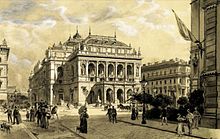
1867 was the year of Reconciliation that brought about the birth of Austria-Hungary. The 19th century was dominated by the Hungarian struggle for independence and modernization. The national insurrection against the Habsburgs began in the Hungarian capital in 1848 and was defeated a little more than a year later.This made Budapest the twin capital of a dual monarchy. It was this compromise which opened the second great phase of development in the history of Budapest, lasting until World War I. In 1849 the Chain Bridge linking Buda with Pest was opened as the first permanent bridge across the Danube and in 1873 Buda and Pest were officially merged with the third part, Óbuda (Ancient Buda), thus creating the new metropolis of Budapest. The dynamic Pest grew into the country's administrative, political, economic, trade and cultural hub. Ethnic Hungarians overtook Germans in the second half of the 19th century due to mass migration from the overpopulated rural Transdanubia and Great Hungarian Plain. Between 1851 and 1910 the proportion of Hungarians increased from 35.6% to 85.9%, Hungarian became the dominant language, and German was crowded out. The proportion of Jews peaked in 1900 with 23.6%. Due to the prosperity and the large Jewish community of the city at the start of the 20th century, Budapest was often called the "Jewish Mecca" or "Judapest".
In 1918 Austria-Hungary lost the war and collapsed; Hungary declared itself an independent republic. In 1920 the Treaty of Trianon finalized the country's partition, as a result, Hungary lost over two-thirds of its territory, and about two-thirds of its inhabitants under the treaty, including 3.3 million out of 10 million ethnic Hungarians.
In 1944, towards the end of World War II, Budapest was partly destroyed by British and American air raids. From 24 December 1944 to 13 February 1945, the city was besieged during the Battle of Budapest. Budapest suffered major damage caused by the attacking Soviet and Romanian troops and the defending German and Hungarian troops. All bridges were destroyed by the Germans. Luckily, the stone lions of the Chain Bridge that have taken their place in 1852 survived the devastation of the war. More than 38,000 civilians lost their lives during the conflict.
Between 20% and 40% of Greater Budapest's 250,000 Jewish inhabitants died through Nazi and Arrow Cross Party genocide during 1944 and early 1945. The Swedish diplomat Raoul Wallenberg managed to save the lives of tens of thousands of Jews in Budapest by giving them Swedish passports and taking them under his consular protection.
In 1949, Hungary was declared a communist People's Republic. The new Communist government considered the buildings like the Buda Castle symbols of the former regime, and during the 1950s the palace was gutted and all the interiors were destroyed.
In 1956, peaceful demonstrations in Budapest led to the outbreak of the Hungarian Revolution. This uprising was an anti-soviet revolt that lasted from the 23th of October until the 11th of November. The Leadership collapsed after mass demonstrations began on 23 October, but Soviet tanks entered Budapest to crush the revolt. Fighting continued until early November, leaving more than 3000 dead. This was the biggest tragedy for Hungary and to commemorate this sorrowful event, a monument was erected at the 50 years anniversary of the revolt in 2006, at the edge of the City Park. Its shape is a wedge with a 56 angle degree made in rusted iron that gradually becomes shiny, ending in an intersection to symbolize Hungarian forces that temporarily eradicated the Communist dictatorship.
From the 1960s to the late 1980s Hungary was often satirically referred to as " the happiest barrack" within the Eastern bloc, and much of the wartime damage to the city was finally repaired. Work on Erzsébet Bridge, the last to be rebuilt, was finished in 1964. In the early 1970s, Budapest Metro's East-West M2 line was first opened, followed by the M3 line in 1982. In 1987, Buda Castle and the banks of the Danube were included in the UNESCO list of World Heritage Sites. Andrassy Avenue (including the Millennium Underground Railway, Hősök tere, and Városliget) was added to the UNESCO list in 2002. In the 1980s the city's population reached 2.1 million. In recent times a significant decrease in population occurred mainly due to a massive movement to the neighbouring agglomeration in Pest county.
In the last decades of the 20th century the political changes of 1989–90 concealed changes in civil society and along the streets of Budapest. The monuments of the dictatorship were taken down from public places, into Memento Park. In the first 20 years of the new democracy, the development of the city was managed by Gábor Demszky.
Timeline of the history of Budapest

| Year | Event |
|---|---|
| BC | Neolithic, Chalcolithic-, bronze and iron age cultures, Celtic and Eravisci settlements on present day Budapest. |
| 1st century | Romans found the settlements known as Aquincum, Contra-Aquincum and Campona. Aquincum becomes the largest town of the Danubian region and one of the capitals of Pannonia. |
| 5th century | The Age of Huns. King Attila builds a city for himself here according to later chronicles. After his death, the sons of his brother Mundzuk (Hungarian: Bendegúz, Turkish: Boncuk), Attila and Bleda ( Hungarian:Buda), in control of the united Hun tribes. |
| 896 | Following the foundation of Hungary, Árpád, leader of the Magyars from the east (present day Hungarians), settles in the "Town of Attila", usually identified as Aquincum. |
| 1046 | Bishop Gellért dies at the hands of pagans on present-day Gellért Hill. |
| 1241 | Tatar invasions destroy both towns. King Béla IV builds the first royal castle on Castle Hill, Buda in 1248. The new town adopts the name of Buda from the earlier one (present day Óbuda). Pest is surrounded by city walls. |
| 1270 | Saint Margaret of Hungary dies in a cloister on the Isle of Rabbits (present day Margaret Island). |
| 1458 | The noblemen of Hungary elect Matthias Corvinus (in Latin) or Hunyadi Mátyás (in Hungarian) as king on the ice of the Danube. Under his reign Buda becomes a main hub of European Renaissance. He dies in 1490, after capturing Vienna in 1485. |
| 1541 | The beginning of Ottoman occupation. The Turkish Pashas build multiple mosques and baths in Buda. |
| 1602 | An unsuccessful assault on Budapest under Feldmarschall Christof Hermann Graf von Rußworm (2 October - 15 November 1602). |
| 1686 | Buda and Pest are reconquered from the Turks with Habsburg leadership. Both towns are destroyed completely in the battles. |
| 1690s | Resettlement of Hungary, initially only a few hundred German settlers. |
| 1773 | Election of the first Mayor of Pest. |
| 1777 | Maria Theresa of Austria moves Nagyszombat University to Castle Hill. |
| 1783 | Joseph II places the acting government (Helytartótanács) and Magyar Kamara on Buda. |
| 1795 20 May | Ignác Martinovics and other Jacobin leaders are executed on Vérmező or 'The Field of Blood'. |
| 1810 | A fire in the Tabán district. |
| 1825 | Commencement of the Reform Era. Pest becomes the cultural and economic centre of the country. The first National Theatre is built, along with the Hungarian National Museum. |
| 1838 | The biggest flood in recent memory in March completely inundates Pest. |
| 1848 15 March | Start of the Revolution and War of Independence of 1848-49. Pest replaces Pozsony/Pressburg (Bratislava) as the new capital of Hungary and seat of the Batthyány government and the Parliament. |
| 1849 | The Austrians occupy the city in early January, but the Hungarian Honvédsereg (Army of National Defense) reclaims it in April, taking the fortress of Buda on 21 May after an 18-day siege. In July, the Habsburg army again captures the two towns. |
| 1849 6 October | Lajos Batthyány, the first Hungarian Prime Minister is executed on the present-day Szabadság tér. |
| 1849 | Széchenyi Lánchíd, or Széchenyi Chain Bridge, the first permanent bridge across the Danube in Budapest was opened linking Buda (West bank) and Pest (East bank). |
| 1867 | Austro-Hungarian Compromise of 1867, followed by unprecedented civic development, resulting in the style of present day Budapest. |
| 1873 | The former cities: Pest, Buda and Óbuda are united, and with that the Hungarian capital is established with the name of Budapest. |
| 1874 | The Budapest Cog-wheel Railway service is inaugurated. |
| 1878 | Electric public lighting was installed in all streets of the city centre. The first telephone exchange was installed in Budapest. |
| 1893 | Electrification of Budapest finished |
| 1896 | Millennium celebrations, the Millennium Underground is inaugurated, and the Ferenc József híd (today's Freedom Bridge) is opened. |
| 1909–1910 | Electric public lighting expanded to the suburbs, the nearby towns villages had Electric public lighting. |
| 1910 | The census finds 880,000 people in Budapest and 55,000 in the largest suburb of Újpest (now part of Budapest). |
| 1918–1919 | Following the conclusion of World War I, the Hungarian Republic of Councils is founded and 133 days later overthrown by the Romanian army which then makes excessive requisitions in Budapest. They regarded this as gathering war reparations, while others classify it as looting. |
| 1924 | Hungarian National Bank is founded. |
| 1925 | Hungarian Radio commences broadcasting. |
| 1933 | Disassembly of the Tabán commences. |
| 1944 19 March | The Germans occupy Budapest. At the time of the occupation, there were 184,000 Jews and between 65,000 and 80,000 Christians of Jewish descent in the town. The Arrow Cross collaborated with the Germans in murdering Jews. Fewer than half of Budapest's Jews (approximately 119,000) survived the following 11 months. |
| 1944 26 December - 13 February | Soviet and Romanian troops besiege Budapest from 15 to 18 January. The retreating Germans destroy all Danube bridges. On 18 January, the Soviets complete the occupation of Pest. The Buda castle falls on 13 February. World War II took the lives of close to 200,000 Budapest residents and caused widespread damage to nearly all of the buildings in the city. |
| 1956 23 October - 4 November | The Hungarian Revolution of 1956 breaks out, ending in the invasion of a large Soviet force. |
| 1960s | Wartime damage is largely repaired. Work on the final bridge to be repaired, the Elizabeth Bridge is finished in 1964. |
| 1970–1972 | The first phase of the East-Western Metro begins. |
| 1982 | The first phase of the North-Southern Metro begins. |
| 1987 | Castle Hill and the banks of the Danube are included in the UNESCO World Heritage Sites. |
| 1989 | 19 August. Hundreds of East German citizens escape to West at the western frontier of Hungary with the help of the Hungarian Democratic Forum. |
| 1990 | The city is home to 2,016,100 residents. |
| 2002 | Andrássy Avenue is added to the list of World heritage Sites, along with the Millennium Underground railway and Heroes' Square. |
| 2006 | 2006 Hungarian protests. |
| 2010 | Sewage treatment of the city reaches 100% of generated sewage. |
Geography
The 525 km2 area of Budapest lies in central Hungary surrounded by settlements of the agglomeration in Pest county. The capital extends 25 and 29 kilometers in the north-south, east-west direction respectively. The Danube enters the city from the north; later it encircles two islands, Óbuda Island and Margaret Island. The third island Csepel Island is the largest of the Budapest Danube islands, however only its northernmost tip is within city limits. The river that separates the two parts of the city is only 230 m (755 ft) wide at its narrowest point in Budapest. Pest lies on the flat terrain of the Great Plain while Buda is rather hilly. Pest's terrain rises with a slight eastward gradient, so the easternmost parts of the city lie at the same altitude as Buda's smallest hills, notably Gellért Hill and Castle Hill. The Buda hills consist mainly of limestone and dolomite, the water created speleothems, the most famous ones being the Pálvölgyi cave and the Szemlőhegyi cave. The hills were formed in the Triassic Era. The highest point of the hills and of Budapest is János hill, at 527 metres (1,729 ft) above sea level. The lowest point is the line of the Danube which is 96 metres (315 ft) above sea level. The forests of Buda hills are environmentally protected.
Climate
The city has a humid continental, transitional climate - somewhere between the mild, snowy weather of Transdanubia, the variable continental climate of the flat and open Great Plain to the east and the almost sub-Mediterranean weather of the south. The climate of Budapest until some years ago was more rigid and cold during the winter and warm during the summer. But probably because of the global warming the weather is getting milder. During the spring the weather is agreeable at day and fresh at night. The summer temperatures are warm, this season is usually the most humid in which sudden heavy showers are the norm. Just as in the spring, the autumn is characterized by little rain and long sunny days (except of November that is one of the most rainy months). During the winter the snow is pretty rare and it lasts just for few days. The temperature under 0° are the norm.
| Climate data for Budapest | |||||||||||||
|---|---|---|---|---|---|---|---|---|---|---|---|---|---|
| Month | Jan | Feb | Mar | Apr | May | Jun | Jul | Aug | Sep | Oct | Nov | Dec | Year |
| Record high °C (°F) | 18.1 (64.6) |
19.7 (67.5) |
25.4 (77.7) |
30.2 (86.4) |
34.0 (93.2) |
39.5 (103.1) |
40.7 (105.3) |
39.4 (102.9) |
35.2 (95.4) |
30.8 (87.4) |
22.6 (72.7) |
19.3 (66.7) |
40.7 (105.3) |
| Average high °C (°F) | 1.2 (34.2) |
4.5 (40.1) |
10.2 (50.4) |
16.3 (61.3) |
21.4 (70.5) |
24.4 (75.9) |
26.5 (79.7) |
26.0 (78.8) |
22.1 (71.8) |
16.1 (61) |
8.1 (46.6) |
3.1 (37.6) |
15.0 (59) |
| Daily mean °C (°F) | −1.6 (29.1) |
1.1 (34) |
5.6 (42.1) |
11.1 (52) |
15.9 (60.6) |
19.0 (66.2) |
20.8 (69.4) |
20.2 (68.4) |
16.4 (61.5) |
11.0 (51.8) |
4.8 (40.6) |
0.4 (32.7) |
10.4 (50.7) |
| Average low °C (°F) | −4.0 (24.8) |
−1.7 (28.9) |
1.7 (35.1) |
6.3 (43.3) |
10.8 (51.4) |
13.9 (57) |
15.4 (59.7) |
14.9 (58.8) |
11.5 (52.7) |
6.7 (44.1) |
2.1 (35.8) |
−1.8 (28.8) |
6.3 (43.3) |
| Record low °C (°F) | −25.6 (−14.1) |
−23.4 (−10.1) |
−15.1 (4.8) |
−4.6 (23.7) |
−1.6 (29.1) |
3.0 (37.4) |
5.9 (42.6) |
5.0 (41) |
−3.1 (26.4) |
−9.5 (14.9) |
−16.4 (2.5) |
−20.8 (−5.4) |
−25.6 (−14.1) |
| Precipitation mm (inches) | 38.5 (1.516) |
36.7 (1.445) |
37.4 (1.472) |
47.2 (1.858) |
64.5 (2.539) |
69.8 (2.748) |
50.4 (1.984) |
49.5 (1.949) |
42.7 (1.681) |
46.9 (1.846) |
59.9 (2.358) |
49.3 (1.941) |
592.8 (23.339) |
| Avg. precipitation days | 7 | 6 | 6 | 6 | 8 | 8 | 7 | 6 | 5 | 5 | 7 | 7 | 78 |
| Mean monthly sunshine hours | 55 | 84 | 137 | 182 | 230 | 248 | 274 | 255 | 197 | 156 | 67 | 48 | 1,933 |
| Source: www.met.hu | |||||||||||||
Sports
Budapest has seven professional football teams, six of them have won the Hungarian 1st division.
City Park (Városliget) and Margit Island are perfect places to find some green area in the city. In the City Park in winter you can enjoy ice skating on one of the largest artificial ice surfaces in the world. Margaret Island offers a wide range of sports from running and cycling to tennis or swimming in the Alfréd Hajós Swimming Centre where Budapest proudly hosted the LEN European Aquatics Championships in 2006 and 2010. Budapest was the host for the ITU Triathlon World Championships 2010, too. The 2011 IIHF World Championship (Division I, Group A) and Athletics - 2012 European Cross Country Championships will be held there.
The city is the proud home for many Olympic, World, and Europen Championship winners and medalists. The city's largest football stadium is named after the world famous Ferenc Puskás; top class player of Real Madrid and the Hungarian National Team, who was recognized as the top scorer of the 20th century and who the FIFA's Puskás Award ( Ballon d'Or) was named after. (read more about the award {|here})
The city is also home to Hungarian bandy. The Bandy World Championship for women 2007 and the Bandy World Championship 2004 /B-group/ were held here.
The Hungarian Grand Prix in Formula 1 is a recurring event since 1986, being held at the Hungaroring just outside the city.
Population
| Historical population | ||
|---|---|---|
| Year | Pop. | ±% |
| 1873 | 296,867 | — |
| 1880 | 370,767 | +24.9% |
| 1890 | 506,384 | +36.6% |
| 1900 | 733,358 | +44.8% |
| 1910 | 880,371 | +20.0% |
| 1920 | 928,996 | +5.5% |
| 1930 | 1,006,184 | +8.3% |
| 1941 | 1,164,963 | +15.8% |
| 1944 | 1,235,920 | +6.1% |
| 1945 | 832,800 | −32.6% |
| 1947 | 1,073,444 | +28.9% |
| 1873–1949 ( Little Budapest) | ||
| Historical population | ||
|---|---|---|
| Year | Pop. | ±% |
| 1950 | 1,629,000 | — |
| 1956 | 1,848,000 | +13.4% |
| 1958 | 1,764,000 | −4.5% |
| 1960 | 1,804,606 | +2.3% |
| 1970 | 2,001,083 | +10.9% |
| 1980 | 2,059,226 | +2.9% |
| 1990 | 2,016,681 | −2.1% |
| 2001 | 1,777,921 | −11.8% |
| 2005 | 1,695,814 | −4.6% |
| 2011 | 1,737,000 | +2.4% |
| 1950-present ( Greater Budapest) | ||
Ethnic groups
| Ethnic groups | Population | % of total |
|---|---|---|
| Hungarians | 1,631,043 | 91.2 |
| Germans | 18,097 | 1 |
| Roma | 14,019 | ~0.8 |
| Slovaks | 4,929 | ~0.3 |
| Others | 16,762 | ~0.9 |
| No answer, unknown | 93,071 | 5.2 |
| Total | 1,777,921 | 100 |
A KSH report showed that the proportion of Roma in Budapest increased from 2% in 1990 to 4.6% in 2009 due to moving of middle class and upper middle class ethnic Hungarians to the suburbs.
Whilst only 1.7% of the population of Hungary in 2009 were foreigners, 43% of them lived in Budapest, making them 4.4% of the city's population. Nearly two-thirds of foreigners living in Hungary were under 40. The primary motivation for this age group living in Hungary was employment.
Religions
| Denominations | Population | % of total |
|---|---|---|
| Christian | 1,128,502 | 63.5 |
| Roman Catholic | 808,460 | 45.5 |
| Calvinist | 224,169 | 12.6 |
| Lutheran | 46,449 | 2.6 |
| Greek Catholic | 28,901 | 1.6 |
| Other | 20,523 | 1.2 |
| Non-Christian religious | 15,439 | ~0.9 |
| Jewish | 9,468 | ~0.5 |
| Other | 5,971 | ~0.3 |
| Without denomination | 347,209 | 19.5 |
| No answer, unknown | 286,584 | 16.1 |
| Total | 1,777,921 | 100 |
Districts
Originally Budapest had 10 districts after coming into existence upon the unification of the three cities in 1873. On 1 January 1950 Budapest was united with several neighboring towns and the number of its districts was raised to 22 ( Greater Budapest). At that time there were changes both in the order of districts and in their sizes. Now there are 23 districts, 6 in Buda, 16 in Pest and 1 on Csepel Island between them. Each district can be associated with one or more city parts named after former towns within Budapest. The city centre itself in a broader sense comprises the 5th, 6th, 7th, 8th, 9th and 13th districts on the Pest side, and the 1st, 2nd, 11th and 12th on the Buda side of the city.
Economy
Budapest became a global city due to industrialization. In 1910, 45.2% of the total population were factory workers. The Hungarian capital was one of the largest industrial cities in Europe with 600,000 factory workers in the 1960s. Between 1920 and the 1970s more than half of Hungary's total industrial output was made in Budapest. Metalworking ( FÉG), textile industry and automobile industry ( Ikarus) were the main sectors before the structural changes.
Now nearly all branches of industry can be found in Budapest. Main products are communication engineering and computer appliances, electric machines, incandescent lamps (General Electric). Pharmaceutical industry is also important, well-known Egis, Gedeon Richter Ltd. and Chinoin companies are Hungarian, Teva also has a division here.
Industry is rather in the suburbs, the centre is place for the main national and international service and financial companies like Hungarian Telekom, General Electric, Vodafone, Telenor, Erste Bank, CIB Bank, K&H Bank&Insurance, UniCredit, Budapest Bank, Generali Providencia Insurance, ING, Aegon Insurance, Allianz. Regional base of Volvo Co., Saab, Ford, GE, IBM, TATA Consultancy Services Limited are in Budapest. MOL Hungarian Oil and Gas Company which with its Subsidiaries, is a leading integrated oil and gas company in Central & Eastern Europe, and OTP Bank which is the biggest Hungarian bank, with branches in 8 other countries as well, are based in the capital.
Budapest is the centre of services, financial counselling, money transactions, commercial and estate services. Trade and logistic services are well-developed. Tourism and catering also deserve mention, the capital being home to thousands of restaurants, bars, coffee houses and party places.
Main sights
| Budapest, including the Banks of the Danube, the Buda Castle Quarter and Andrássy Avenue | |
|---|---|
| Name as inscribed on the World Heritage List | |
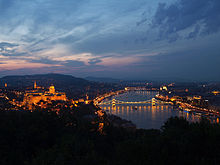 |
|
| Country | Hungary |
| Type | Cultural |
| Criteria | i, ii, vi |
| Reference | 400 |
| UNESCO region | Europe and North America |
| Inscription history | |
| Inscription | 1987 (11th Session) |
The neo-Gothic Parliament, the biggest building in Hungary with its 268 meter length, containing amongst other things the Hungarian Crown Jewels. Saint Stephen's Basilica, where the Holy Right Hand of the founder of Hungary, King Saint Stephen is on display. The Hungarian cuisine and café culture: for example, Gerbeaud Café, and the Százéves, Biarritz, Fortuna, Alabárdos, Arany Szarvas, Kárpátia and the world famous Mátyás Pince Restaurants. There are Roman remains at the Aquincum Museum, and historic furniture at the Nagytétény Castle Museum, just 2 out of 223 museums in Budapest. Another historical museum is the House of Terror, hosted in the building that was the venue of the Nazi headquarters.
The Castle Hill, the River Danube embankments and the whole of Andrássy út have been officially recognized as UNESCO World Heritage Sites.
Castle Hill and the Castle District; there are three churches here, six museums, and a host of interesting buildings, streets and squares. The former Royal Palace is one of the symbols of Hungary – and has been the scene of battles and wars ever since the 13th century. Nowadays it houses two impressive museums and the National Széchenyi Library. The nearby Sándor Palace contains the offices and official residence of the President of Hungary. The seven-hundred year-old Matthias Church is one of the jewels of Budapest, it is in neo-Gothic style, decorated with coloured shingles and elegant pinnacles. Next to it is an equestrian statue of the first king of Hungary, King Saint Stephen, and behind that is the Fisherman's Bastion, built in 1905 by the architect Frigyes Schulek, the Fishermen's Bastions owes its name to the namesake corporation that during the Middle Ages was responsible of the defence of this part of ramparts, from where opens out a panoramic view of the whole city. Statues of the Turul, the mythical guardian bird of Hungary, can be found in both the Castle District and the Twelfth District.
In Pest, arguably the most important sight is Andrássy út. This Avenue is an elegant 2.5 km (2 mi) long tree-lined street that covers the distance from Deák Ferenc tér to the Heroes Square. On this Avenue overlook many important sites. It is a UNESCO heritage site. As far as Kodály Körönd and Oktogon both sides are lined with large shops and flats built close together. Between there and Heroes' Square the houses are detached and altogether grander. Under the whole runs continental Europe's oldest Underground railway, most of whose stations retain their original appearance. Heroes' Square is dominated by the Millenary Monument, with the Tomb of the Unknown Soldier in front. To the sides are the Museum of Fine Arts and the Kunsthalle Budapest, and behind City Park opens out, with Vajdahunyad Castle. One of the jewels of Andrássy út is the Hungarian State Opera House. Statue Park, a theme park with striking statues of the Communist era, is located just outside the main city and is accessible by public transport.
The city is home to the largest synagogue in Europe ( Dohány Street Synagogue), and second largest working in the World. The synagogue is located in the Jewish district taking up several blocks in central Budapest bordered by Király utca, Wesselényi utca, Grand Boulevard (Budapest) and Bajcsy Zsilinszky road. It was built in moorish revival style in 1859 and its capacity is 3000 people. Next to it is located a sculpture reproducing a weeping willow tree in steel to commemorate the Hungarian victims of the Holocaust. The city is also proud at the largest medicinal bath in Europe ( Széchenyi Medicinal Bath) and the third largest Parliament building in the world, once the largest in the world. The third largest church in Europe ( Esztergom Basilica) and the second largest Baroque castle in the world ( Gödöllő) are in the vicinity. Other attractions are the bridges of the capital. Budapest is crossed by seven bridges (from north to south): the Árpád bridge (built in 1950 at the north of Margaret Island); the Margaret bridge (built in 1901, destroyed during the war by an explosion and then rebuilt in 1948); the Chain bridge (built in 1849, destroyed during the II World War and the rebuilt in 1949); the Elisabeth bridge (completed in 1903 and dedicated to the murdered Queen Elizabeth, it was destroyed by the German during the war and rebuilt in 1964); the Liberty bridge (opened in 1896 and rebuilt in 1989 in Art Nouveau style); the Petőfi bridge (completed in 1937, destroyed during the war and rebuilt in 1952); the Rákóczi bridge (completed in 1995). Most remarkable for their beauty are the Margaret bridge, the Chain bridge and the Liberty bridge.
The world's largest panorama photograph was created in (and of) Budapest in 2010.
Islands
Seven islands can be found on the Danube: Shipyard Island, Margaret Island, Csepel Island, Palotai-sziget (now a peninsula), Népsziget, Háros-sziget, and Molnár-sziget.
Notable islands include:
- Margaret Island is a 2.5 km (1.6 mi) long island and 0.965 square kilometres (238 acres) in area. The island mostly consists of a park and is a popular recreational area for tourists and locals alike. The island lies between bridges Margaret Bridge (south) and Árpád Bridge (north). Dance clubs, Swimming pools, an Aqua park, athletic and fitness centres, bicycle and running tracks can be found around the Island. During the day the island is occupied by people doing sports, or just resting. In the summer (generally on the weekends) mostly young people go to the island at night to party in its terraces, or to recreate with a bottle of alcohol on a bench or on the grass (this form of entertainment is sometimes referred to as bench-partying).
- Csepel Island (Hungarian pronunciation: [ˈtʃɛpɛlsiɡɛt]) is the largest island of the River Danube in Hungary. It is 48 km (30 mi) long; its width is 6–8 km (3.75–5 mi) and its area comprises 257 km2 (99 sq mi), whereas only the northern tip is inside the city limits.
- Hajógyári-sziget ( [ˈhɒjoːɟaːri siɡɛt], or Óbudai-sziget) is a man built island, located in the third district. This island hosts many activities such as: wake-boarding, jet-skiing during the day, and dance clubs during the night. This is the island where the famous Sziget Festival takes place, hosting hundreds of performances per year and now around 400,000 visitors in its last edition. Many building projects are taking place to make this island into one of the biggest entertainment centres of Europe, the plan is to build Apartment buildings, hotels, casinos and a marina.
- Luppa-sziget is the smallest island of Budapest, located in the north region.
- Rock of Ínség can be found in the river Danube under the Gellért mountain, it can be seen just in a drought period when the river level is very low and this is a bad signal for a crop.
Spas
One of the reasons the Romans first colonized the area immediately to the west of the River Danube and established their regional capital at Aquincum (now part of Óbuda, in northern Budapest) is so that they could utilize and enjoy the thermal springs. There are still ruins visible today of the enormous baths that were built during that period. The new baths that were constructed during the Turkish period (1541–1686) served both bathing and medicinal purposes, and some of these are still in use to this day. Budapest gained its reputation as a city of spas in the 1920s, following the first realization of the economic potential of the thermal waters in drawing in visitors. Indeed, in 1934 Budapest was officially ranked as a "City of Spas". Today, the baths are mostly frequented by the older generation, as, with the exception of the "Magic Bath" and "Cinetrip" water discos, young people tend to prefer the lidos which are open in the summer. Construction of the Király Baths started in 1565, and most of the present-day building dates from the Turkish period, including most notably the fine cupola-topped pool.
The Rudas Baths are centrally placed – in the narrow strip of land between Gellért Hill and the River Danube – and also an outstanding example of architecture dating from the Turkish period. The central feature is an octagonal pool over which light shines from a 10 m diameter cupola, supported by eight pillars.
The Gellért Baths and Hotel were built in 1918, although there had once been Turkish baths on the site, and in the Middle Ages a hospital. In 1927 the Baths were extended to include the wave pool, and the effervescent bath was added in 1934. The well-preserved Art Nouveau interior includes colourful mosaics, marble columns, stained glass windows and statues.
The Lukács Baths are also in Buda and are also Turkish in origin, although they were only revived at the end of the 19th century. This was also when the spa and treatment centre were founded. There is still something of an atmosphere of fin-de-siècle about the place, and all around the inner courtyard there are marble tablets recalling the thanks of patrons who were cured there. Since the 1950s it has been regarded as a centre for intellectuals and artists.
The Széchenyi Baths are one of the largest bathing complexes in all Europe, and the only "old" medicinal baths to be found in the Pest side of the city. The indoor medicinal baths date from 1913 and the outdoor pools from 1927. There is an atmosphere of grandeur about the whole place with the bright, largest pools resembling aspects associated with Roman baths, the smaller bath tubs reminding one of the bathing culture of the Greeks, and the saunas and diving pools borrowed from traditions emanating in northern Europe. The three outdoor pools (one of which is a fun pool) are open all year, including winter. Indoors there are over ten separate pools, and a whole host of medical treatments is also available. The Szécheny Baths are built in modern Renaissance style.
Transport
Airport
Budapest Liszt Ferenc International Airport, formerly called Budapest Ferihegy International Airport, which has only one passenger terminal: Ferihegy 2/A and Ferihegy 2/B connected with the Sky Court building. The airport is located to the east of the centre in the XVIII. district in Pestszentlőrinc. In March 2011, the Hungarian Government announced that the name of the Airport is to be changed from "Budapest Ferihegy International Airport" to "Budapest Liszt Ferenc International Airport".
Outside Budapest, there are alternative international airports in Debrecen, Sármellék, Győr-Pér and Pécs-Pogány, all of which can all be reached within three hours by train or bus.
Roads
Budapest is the most important Hungarian road terminus; most of the major highways end near the city-limits. The road system in the city is designed in a similar manner to that of Paris, with several ring roads, and avenues radiating out from the centre.
Ring road (beltway) M0 around Budapest is nearly completed, with only one section missing on the west side due to local disputes. Currently the beltway is around 80 kilometers in length, and once finished it will be near 100 kilometers of highway in length.
Public transport
Budapest public transport is provided by BKV, the company operates buses, trolleybuses, trams, suburban railway lines, the metro, a boat service, a cogwheel railway, a funicular, and a chairlift, called Libegő.
Budapest's tram network is extensive, and reliable despite poor track infrastructure and an ageing fleet. Routes 4 and 6 combined form the busiest traditional city tram line in the world, with the world's longest passenger trams (54-metre (177 ft) long Siemens Combino) running at 60 to 90 second intervals at peak time and 3–4 minutes off-peak and usually packed with people.
Day services operate from 4:30 am until 11:30 pm each day. Night traffic (a reduced overnight service) has a reputation for being excellent.
There are three metro lines and a fourth is currently under construction. The Yellow line, built in 1896, is one of the oldest subway lines in the world, following the London Underground built in 1863.
Railways
Hungarian main-line railways are operated by MÁV. There are three main railway termini in Budapest, Keleti (eastbound), Nyugati (westbound), and Déli (southbound), operating both domestic and international rail services. Budapest is one of the main stops of the Orient Express on its Central and Eastern European route. There is also a suburban rail service in and around Budapest, operated under the name HÉV.
Waterways
The river Danube flows through Budapest on its way to the Black Sea. The river is easily navigable and so Budapest has historically been a major commercial port (at Csepel). In the summer months a scheduled hydrofoil service operates up the Danube to Vienna. BKV also provides public transport with boat service within the borders of the city. 3 route (marked D11-13) connects the 2 banks with Margaret Island and Hajógyári-sziget, from Római fürdő (Buda side, North to Óbudai sziget) or Árpád Bridge (Pest side) to Rákóczi Bridge, with a total of 15 stops. Several companies provides sightseeing boat trips and also an amphibious vehicle (bus and boat) operates constantly. The Pest side is also a famous port place with an international shipstation.
Special vehicles
Beside metros, suburban rails, buses, trams and boats, there are a couple of less usual vehicles in Budapest:
- trolleybus on several lines in Pest
- the Castle Hill Funicular between the Chain Bridge and Buda Castle
- cyclecar for rent in Margaret Island
- chairlift
- the Budapest Cog-wheel Railway
- children's railway
The latter three vehicles run among Buda hills.
Culture
The dance tradition of the Carpathian Basin is the unique area of the European dance culture, which is also a special transition between the Balkans and Western Europe regions. Several authentic Hungarian folk dance ensembles work in Budapest, some of them professional. Budapest is one of the few cities in the world where a high school for folk dance learning exists.
In Budapest there are currently 837 different monuments, which represent the most of the European artistic style. The classical and unique Hungarian Art Nouveau buildings are prominent.
The city glories in 223 museums and galleries, which presents several memories, not only the Hungarian historical, art and science ones, but also the memories of universal and European culture and science. Here are the greatest examples among them: the Hungarian National Museum, the Hungarian National Gallery, the Museum of Fine Arts, the Budapest Historical Museum, the Memento Park and the Museum of Applied Arts.
In Budapest there are forty theaters, seven concert halls and an opera house. Outdoor festivals, concerts and lectures enrich the cultural offer of summer, which are often held in historical buildings. The largest theatre facilities: the Budapest Operetta and Musical Theatre, the József Attila Theatre, the Katona József Theatre, the Madách Theatre, the Hungarian State Opera House, the National Theatre, the Vigadó, Radnóti Miklós Theatre and the Comedy Theatre.
A lot of libraries have unique collections in Budapest, such as the National Széchenyi Library, which keeps historical relics from the age before the printing of books. The Metropolitan Szabó Ervin Library plays an important role in the general education of the capital's population. Other libraries: The Library of the Hungarian Academy of Sciences, Eötvös University Library, the Parliamentary Library and the National Library of Foreign Literature.
If we mention cultural events, Hungary's the largest outdoor festival is the Sziget Festival, which is really popular in all over Europe, as well. Other major events: Budapest Spring Festival, Budapest Autumn Festival, the Budapest Wine Festival and the Budapest Pálinka Festival.
Tourists visiting Budapest are provided with free maps and information about "points of interest" by BTDM at its info-points.
24 h and 72 h Budapest card is available for visitors. During the card's validity public transport is free, and discount is available in lots of museums, restaurants, and other places of interest.
The city is also well known for its ruin bars.
In fiction
The 1906 novel The Paul Street Boys, the 1937 novel Journey by Moonlight, the 1957 book The Bridge at Andau, the 1975 novel Fateless, the 1977 novel The End of a Family Story, the 1986 book Between the Woods and the Water, the 1992 novel Under the Frog, the 1987 novel The Door, the 2002 novel Prague, the 2003 book Budapeste, the 2004 novel Ballad of the Whisky Robber, the 2005 novels Parallel Stories and The Historian, the 2012 novel Budapest Noir are set, amongst others, partly or entirely in Budapest.
Some of the better known feature films set in Budapest are Kontroll, The District!, Ein Lied von Liebe und Tod, Sunshine, An American Rhapsody, As You Desire Me, The Good Fairy, Hanna's War, The Journey, Ladies in Love, Mehbooba, Music Box, The Shop Around the Corner, Zoo in Budapest, and Mission: Impossible – Ghost Protocol.
Education
Budapest is Hungary's main centre of education and home to numerous universities:
- Eötvös Loránd University
- Budapest Business School
- Central European University
- Budapest University of Technology and Economics
- Corvinus University of Budapest
- Semmelweis University (medical university)
- Szent István University
- Óbuda University
- Pázmány Péter Catholic University
- Károli Gáspár University of the Hungarian Reformed Church
- Jewish Theological Seminary – University of Jewish Studies
- International Business School, Budapest
- Andrássy Gyula German Language University of Budapest
- Moholy-Nagy University of Art and Design
- Liszt Ferenc Academy of Music
International relations
Twin towns and sister cities
Budapest is twinned with:
| Country | City | County / District / Region / State | Date |
|---|---|---|---|
| Istanbul | Istanbul Province | 1985 | |
| Vienna | Vienna | 1990 | |
| Sarajevo | Sarajevo Canton | 1995 | |
| La Paz | La Paz Department | 2009 | |
| Izmir | Izmir Province | 1985 | |
| Sofia | Sofia | ||
| Beijing | Beijing | 2005 | |
| Zagreb | Zagreb | 1994 | |
| Paris | Île-de-France | 1956 | |
| Berlin | Berlin | 1992 | |
| Frankfurt am Main | Hessen | 1990 | |
| Jakarta | Jakarta | 2009 | |
| Tel Aviv | Tel Aviv District | 1989 | |
| Florence | Tuscany | 2008 | |
| Warsaw | Masovian Voivodeship | 2005 | |
| Vilnius | Vilnius County | ||
| Rotterdam | Rotterdam | 1991 | |
| Lisbon | Lisbon district | 1992 | |
| Bucharest | Bucharest | 1991 | |
| Košice | Košice Region | 1997 | |
| Daejeon | Daejeon | 1994 | |
| Bangkok | Bangkok | 2007 | |
| Lviv | Lviv Oblast | 1993 | |
| Fort Worth | Texas | 1990 | |
| Gaziantep | Gaziantep Province | 2010 | |
| New York City | New York | 1992 |
Some of the city's districts are also twinned to small cities or districts of other big cities, for details see the article List of districts and towns in Budapest.
